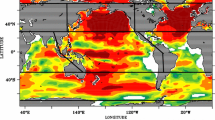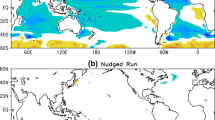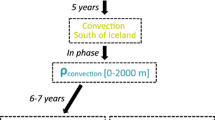Abstract
Initialising the ocean internal variability for decadal predictability studies is a new area of research and a variety of ad hoc methods are currently proposed. In this study, we explore how nudging with sea surface temperature (SST) and salinity (SSS) can reconstruct the three-dimensional variability of the ocean in a perfect model framework. This approach builds on the hypothesis that oceanic processes themselves will transport the surface information into the ocean interior as seen in ocean-only simulations. Five nudged simulations are designed to reconstruct a 150 years “target” simulation, defined as a portion of a long control simulation. The nudged simulations differ by the variables restored to, SST or SST + SSS, and by the area where the nudging is applied. The strength of the heat flux feedback is diagnosed from observations and the restoring coefficients for SSS use the same time-scale. We observed that this choice prevents spurious convection at high latitudes and near sea-ice border when nudging both SST and SSS. In the tropics, nudging the SST is enough to reconstruct the tropical atmosphere circulation and the associated dynamical and thermodynamical impacts on the underlying ocean. In the tropical Pacific Ocean, the profiles for temperature show a significant correlation from the surface down to 2,000 m, due to dynamical adjustment of the isopycnals. At mid-to-high latitudes, SSS nudging is required to reconstruct both the temperature and the salinity below the seasonal thermocline. This is particularly true in the North Atlantic where adding SSS nudging enables to reconstruct the deep convection regions of the target. By initiating a previously documented 20-year cycle of the model, the SST + SSS nudging is also able to reproduce most of the AMOC variations, a key source of decadal predictability. Reconstruction at depth does not significantly improve with amount of time spent nudging and the efficiency of the surface nudging rather depends on the period/events considered. The joint SST + SSS nudging applied everywhere is the most efficient approach. It ensures that the right water masses are formed at the right surface density, the subsequent circulation, subduction and deep convection further transporting them at depth. The results of this study underline the potential key role of SSS for decadal predictability and further make the case for sustained large-scale observations of this field.














Similar content being viewed by others
References
Aumont O, Bopp L (2006) Globalizing results from ocean in situ iron fertilization studies. Global Biogeochem Cycles 20(2):1–15. doi:10.1029/2005GB002591
Barnier B, Siefridt L, Marchesiello P (1995) Thermal forcing for a global ocean circulation model using a three-year climatology of ECMWF analyses. J Mar Syst 6(4):363–380. doi:10.1016/0924-7963(94)00034-9
Boer GJ (2004) Long time-scale potential predictability in an ensemble of coupled climate models. Clim Dyn 23(1):29–44. doi:10.1007/s00382-004-0419-8
Bretherton C, Widmann M, Dymnikov V, Wallace J, Bladé I (1999) The effective number of spatial degrees of freedom of a time-varying field. J Clim 12(1969):1990–2009
Collins M, Sinha B (2003) Predictability of decadal variations in the thermohaline circulation and climate. Geophys Res Lett 30(6):3–6. doi:10.1029/2002GL016504
Cox P, Stephenson D (2007) Climate change. A changing climate for prediction. Science 317(5835):207–208. doi:10.1126/science.1145956
Doblas-Reyes FJ, Andreu-Borillo I, Chikamoto Y, Garcia-Serrano J, Guemas V, Kimoto M, Mochizuki T, van Rodrigues LRL, Oldenborgh GJ (2013) Initialized near-term regional climate change prediction. Nat Commun 4:1715. doi:10.1038/ncomms2704
Du H, Doblas-Reyes FJ, García-Serrano J, Guemas V, Soufflet Y, Wouters B (2012) Sensitivity of decadal predictions to the initial atmospheric and oceanic perturbations. Clim Dyn. doi:10.1007/s00382-011-1285-9
Dufresne J-L, Foujols M-A, Denvil S, Caubel A, Marti O, Aumont O, Benshila R (2013) Climate change projections using the IPSL-CM5 earth system model: from CMIP3 to CMIP5. Clim Dyn 2123–2165. doi:10.1007/s00382-012-1636-1
Dunstone NJ, Smith DM (2010) Impact of atmosphere and sub-surface ocean data on decadal climate prediction. Geophys Res Lett 37(2):1–5. doi:10.1029/2009GL041609
Escudier R, Mignot J, Swingedouw D (2013) A 20-year coupled ocean-sea ice-atmosphere variability mode in the North Atlantic in an AOGCM. Clim Dyn. doi:10.1007/s00382-012-1402-4
Fichefet T, Maqueda MAM (1997) Sensitivity of a global sea ice model to the treatment of ice thermodynamics and dynamics. J Geophys Res 102(C6):12609. doi:10.1029/97JC00480
Frankignoul C, Kestenare E (2002) The surface heat flux feedback. Part I: estimates from observations in the Atlantic and the North Pacific. Clim Dyn 19(8):633–647. doi:10.1007/s00382-002-0252-x
Goelzer H, Mignot J, Levermann A, Rahmstorf S (2006) Tropical versus high latitude freshwater influence on the Atlantic circulation. Clim Dyn 27(7–8):715–725
Griffies SM, Biastoch A, Böning C, Bryan F, Danabasoglu G, Chassignet EP, England MH, Gerdes R, Haak H, Wallberg RW, Hazeleger W, Jungclaus J, Large WG, Madec G, Pirani A, Samuels BL, Scheinert M, Gupta AS, Severijns CA, Simmons HL, Treguier AM, Winton M, Yeager S, Yin J (2009) Coordinated ocean-ice reference experiments (COREs). Ocean Model 26(1–2):1–46
Haney RL (1971) A numerical study of the large scale response of an ocean circulation to surface heat and momentum flux. Ph.D. Dissertation, Department of Meteorology, University of California, Los Angeles
Hawkins E, Sutton R (2009) The potential to narrow uncertainty in regional climate predictions. Bull Am Meteorol Soc 90(8):1095–1107. doi:10.1175/2009BAMS2607.1
Hourdin F, Foujols M-A, Codron F, Guemas V, Dufresne J-L, Bony S, Bopp L (2013) Impact of the LMDZ atmospheric grid configuration on the climate and sensitivity of the IPSL-CM5A coupled model. Clim Dyn 40(9–10):2167–2192. doi:10.1007/s00382-012-1411-3
Joly M, Voldoire A, Douville H, Terray P, Royer JF (2007) African monsoon teleconnections with tropical SSTs in a set of IPCC4 coupled models. Clim Dyn 1–32. doi:10.1007/s00382-006-0215-8
Keenlyside N, Latif M, Botzet M (2005) A coupled method for initializing El Nino Southern Oscillation forecasts using sea surface temperature. Tellus A 340–356. doi:10.1111/j.1600-0870.2005.00107.x
Keenlyside NS, Latif M, Jungclaus J, Kornblueh L, Roeckner E (2008) Advancing decadal-scale climate prediction in the North Atlantic sector. Nature 453(7191):84–88. doi:10.1038/nature06921
Kim HM, Webster PJ, Curry JA (2012) Evaluation of short term climate change prediction in multi-model CMIP5 decadal hindcasts. Geophys Res Lett 39(10):L10701
Krinner G, Viovy N, de Noblet-Ducoudré N, Ogée J, Polcher J, Friedlingstein P, Prentice C (2005) A dynamic global vegetation model for studies of the coupled atmosphere-biosphere system. Global Biogeochem Cycles 19(1). doi:10.1029/2003GB002199
Kröger J, Müller WA, von Storch J-S (2012) Impact of different ocean reanalyses on decadal climate prediction. Clim Dyn 795–810. doi:10.1007/s00382-012-1310-7
Latif M, Collins M, Pohlmann H, Keenlyside N (2006) A review of predictability studies of Atlantic sector climate on decadal time scales. J Clim 19(23):5971–5987
Laurian A, Lazar A, Reverdin G, Rodgers K, Terray P (2006) Poleward propagation of spiciness anomalies in the North Atlantic Ocean. Geophys Res Lett 33(13):1–5. doi:10.1029/2006GL026155
Luo J–J, Masson S, Behera S, Shingu S, Yamagata T (2005) Seasonal climate predictability in a coupled OAGCM using a different approach for. J Clim 18:4474–4497. doi:10.1175/JCLI3526.1
Madec G; NEMO team (2008) NEMO ocean engine. Institut Pierre-Simon Laplace (IPSL)
Merryfield WJ, Lee WS, Boer GJ, Kharin VV, Pal B, Scinocca JF, Flato GM (2010) The first coupled historical forecasting project (CHFP1). Atmosphere-ocean 48(4):263–283
Mignot J, Frankignoul C (2003) On the interannual variability of surface salinity in the Atlantic (May 2002). 555–565. doi:10.1007/s00382-002-0294-0
Mignot Juliette, Frankignoul C (2009) Local and remote impacts of a tropical Atlantic salinity anomaly. Clim Dyn 35(7–8):1133–1147. doi:10.1007/s00382-009-0621-9
Msadek R, Dixon KW, Delworth TL, Hurlin W (2010) Assessing the predictability of the Atlantic meridional overturning circulation and associated fingerprints. Geophys Res Lett 37(19):1–5. doi:10.1029/2010GL044517
Persechino A, Mignot J, Swingedouw D, Labetoulle S, Guilyardi E (2013) Decadal predictability of the Atlantic meridional overturning circulation and climate in the IPSL-CM5A-LR model. Clim Dyn. doi:10.1007/s00382-012-1466-1
Pohlmann H, Jungclaus J, Köhl A, Stammer D, Marotzke J (2009) Initializing decadal climate predictions with the GECCO oceanic synthesis: effects on the North Atlantic. J Clim 22(14):3926–3938. doi:10.1175/2009JCLI2535.1
Schneider N, Venzke S, Miller A, Pierce DW, Deser C, Barnett TP, Latif M (1999) Pacific thermocline bridge revisited. Geophys Res Lett 26(9):1329–1332
Smith DM, Cusack S, Colman AW, Folland CK, Harris GR, Murphy JM (2007) Improved surface temperature prediction for the coming decade from a global climate model. Science 317(5839):796–799. doi:10.1126/science.1139540
Speer K, Tziperman E (1992) Rates of water mass formation in the North Atlantic. J Phys Oceanogr 22:93–104
Speer BK, Guilyardi E, Madec G, Cnrs POI (2000) Southern Ocean transformation in a coupled model with and without eddy mass fluxes. Tellus A 52(5):554–565
Stepanov VN, Haines K, Smith GC (2012) Assimilation of RAPID array observations into an Ocean model. Quart J R Meteorol Soc 138(669):2105–2117. doi:10.1002/qj.1945
Swingedouw D, Braconnot P, Delecluse P, Guilyardi E, Marti O (2007a) The impact of global freshwater forcing on the thermohaline circulation: adjustment of North Atlantic convection sites in a CGCM. Clim Dyn 28:291–305
Swingedouw D, Braconnot P, Delecluse P, Guilyardi E, Marti O (2007b) Quantifying the AMOC feedbacks during a 2xCO2 stabilization experiment with land-ice melting. Clim Dyn 29:521–534
Swingedouw D, Mignot J, Labetoulle S, Guilyardi E, Madec G (2013) Initialisation and predictability of the AMOC over the last 50 years in a climate model. Clim Dyn 40:2381–2399. doi:10.1007/s00382-012-1516-8
Taylor KE, Stouffer RJ, Meehl GA (2012) An overview of CMIP5 and the experiment design. Bull Am Meteoroll Soc 93(4):485–498
Valcke S (2012) The OASIS3 coupler: a European climate modelling community software. Geosci Model Dev Discuss 5(3):2139–2178. doi:10.5194/gmdd-5-2139-2012
Von Storch H, Zwiers FW (2002) Statistical analysis in climate research. Cambridge University Press, p 496
Walin G (1982) On the relation between sea-surface heat flow and thermal circulation in the ocean. Tellus 34(2):187–195. doi:10.1111/j.2153-3490.1982.tb01806.x
Xie S-P, Carton JA (2004) Tropical Atlantic variability: patterns, mechanisms, and impacts. Geophys Monogr Ser 147:121–142. doi:10.1029/147GM07
Yu L (2011) A global relationship between the ocean water cycle and near-surface salinity. J Geophys Res 116(C10):C10025. doi:10.1029/2010JC006937
Zhang R, Delworth TL (2006) Impact of Atlantic multidecadal oscillations on India/Sahel rainfall and Atlantic hurricanes. Geophys Res Lett 33(17):L17712. doi:10.1029/2006GL026267
Zhang S, Harrison MJ, Rosati A, Wittenberg A (2007) System design and evaluation of coupled ensemble data assimilation for global oceanic climate studies. Mon Wea Rev 135(10):3541–3564. doi:10.1175/MWR3466.1
Zhang S, Rosati A, Delworth T (2010) The adequacy of observing systems in monitoring the atlantic meridional overturning circulation and North Atlantic climate. J Clim 23(19):5311–5324. doi:10.1175/2010JCLI3677.1
Zhang R, Zheng F, Zhu J, Pei Y (2012) Modulation of El Nino-Southern Oscillation by Freshwater Flux by Freshwater Flux and Salinity Variability in the Tropical Pacific. Adv Atmos 29(4):647–660. doi:10.1007/s00376-012-1235-4.1
Zheng F, Zhang R-H (2012) Effects of interannual salinity variability and freshwater flux forcing on the development of the 2007/08 La Niña event diagnosed from Argo and satellite data. Dyn Atmos Oceans 57:45–57. doi:10.1016/j.dynatmoce.2012.06.002
Acknowledgments
We acknowledge Gurvan Madec and Sulagna Ray for helpful discussions, Marie-Alice Foujols and Sébastien Denvil for help with the model and data handling. This study was partly funded by the EPIDOM project (GICC) by the EU project SPECS funded by the European Commission’s Seventh Framework Research Programme under the grant agreement 243964. Computations were carried out at the CCRT supercomputing centre.
Author information
Authors and Affiliations
Corresponding author
Appendix: Statistical methods
Appendix: Statistical methods
The influence of the nudging method is assessed by quantifying the agreement in terms of temporal variations between the target and the nudged simulations with the help of statistical skill scores.
The first score is the correlation coefficient R (Eq. (1), significance estimated with a Student t test) to quantify the temporal agreement between the target and the nudged simulations.
X and Y are the same variable, X is the nudged simulation and Y the target; t represents the time, T is the length of the period, the overbar denotes a time average over which this quantity is computed (usually the length of the nudged simulations) and \(\sigma_{X}\) and σ Y are the standard deviation of X and Y respectively. The Pearson correlation coefficient (commonly used correlation coefficient) is used for Gaussian variables, like temperature, salinity and AMOC index. For non-Gaussian variables (precipitation and mixed-layer depth), a Spearman’s rank correlation coefficient is used.
To compare the amplitude of the simulated variability with the target, a Fisher F test on the ratio of variance is performed (Von Storch and Zwiers (2002)). For non-Gaussian variables (such as precipitation), the Fisher F-test is applied on the logarithm of the strictly positive values of the time series.
Estimating the significance of a correlation on 150 years of an oceanic variable as a function of depth has to deal with a low number of degrees of freedom of the time series, due to the presence of potentially dominating low frequency (multi-decadal and more). An iterative detrending procedure (see Boer (2004)) has therefore been used to remove this low frequency: a linear trend is first removed from the time series at the first iteration, and the amount of the total variance of the detrended time series that this trend represents is evaluated. If it represents more than 5 % of the variance of the detrended time series, a spline of growing order (second, third…) is iteratively removed until the variance of the lastly removed trend represents less than 5 % of the variance of the detrended time series. With this procedure, the highest order of spline removed was six. We computed the autocorrelation function of a set of randomly chosen detrended time series, and checked that this detrending procedure retains the decadal variability. It is important to note here that this detrending procedure allows estimating correlation coefficients on time series with more than ten degrees of freedom, which is much more relevant in terms of statistics than on time series presenting important trends and having not more than five degrees of freedom. However, the decadal variability of a temperature time series at more than one thousand meters in depth can be quite small compared to the amplitude of the trends. This limitation has been kept in mind when interpreting the results.
The statistical significance is computed by taking into account the serial correlation of the time series in the estimation of the number of degrees of freedom (Bretherton et al. 1999). Nevertheless, and despite the detrending procedure, some significant correlations between the free run and the target still appear. Because no causal relationship behind these correlations is assumed, we have highlighted the correlation coefficients between the nudged simulations and the target that are not significantly different (test of the difference of correlation based on the Fisher transform at the 99 % level) in absolute value from the corresponding correlation coefficient in absolute value between the target and the free run. Correlation coefficients failing this last test have to be interpreted carefully.
A bootstrap method using the 1,000 years of the control simulation was also used to estimate the significance of the correlation and gave the same estimation of significance than the method described above.
In this study, a variable or a phenomenon is qualified as “reconstructed” or “reproduced” when a certain level of agreement between a given nudged simulation and the target, and as computed with these statistical tools, has been shown.
Rights and permissions
About this article
Cite this article
Servonnat, J., Mignot, J., Guilyardi, E. et al. Reconstructing the subsurface ocean decadal variability using surface nudging in a perfect model framework. Clim Dyn 44, 315–338 (2015). https://doi.org/10.1007/s00382-014-2184-7
Received:
Accepted:
Published:
Issue Date:
DOI: https://doi.org/10.1007/s00382-014-2184-7




